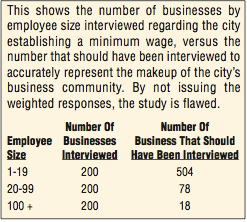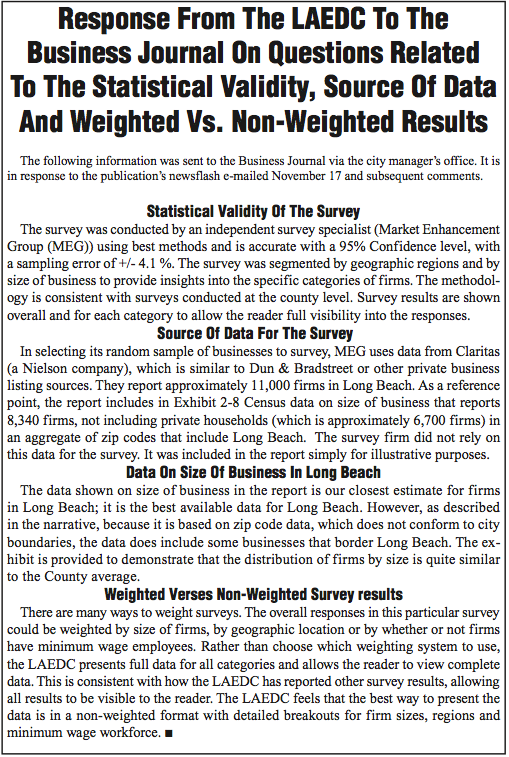Soon after the minimum wage study requested by the mayor and city council was released on November 13, the Business Journal called its results into question – specifically because of the parameters used to develop the analysis, or what the study calls “What This Tells Us.”
What the study tells us is that the results are significantly skewed against small businesses.
In short, the data compiled from interviews with 600 Long Beach businesses in the report were not weighted to account for the fact that small businesses – those with fewer than 20 employees – comprise an overwhelming majority of businesses in the city: 84% in fact. Any valid analysis would acknowledge this reality by either conducting a proportional number of interviews with small, medium and large employers; or, if equal numbers of interviews are conducted with the three groups, weight the data accordingly. This ensures that the business owners interviewed are a true representation of the Long Beach business community. That, according to several companies that conduct surveys, is necessary to ensure accurate data prior to interpreting that data and issuing a report.

The result is that unless the company contracted by the city – the Institute of Applied Economics of the Los Angeles County Economic Development Corporation (LAEDC) – reissues its report based on weighted data, the November 13 report that has been widely distributed is misleading with conclusions that do not reflect the real community of Long Beach businesses.
Let us explain.
The LAEDC decided on the parameters to be used for the survey. It said 600 business owners would be surveyed to determine the impacts on their business if Long Beach establishes a citywide minimum wage. LAEDC then, incorrectly, decided to evenly divide the 600 businesses into three employee-size categories: 1 to 19; 20 to 99; and 100 or more. LAEDC further decided to separate the city into three regions by zip code.
The end result is that 200 businesses in each region were interviewed, and within each region a third of the 200 businesses interviewed have 19 or fewer employees, a third have 20-99 employees and a third have 100 or more employees. The problem is that the matrix is not representative of the city’s business makeup – which, again, is overwhelmingly small businesses employing 19 or fewer people.
There are currently 11,077 businesses in Long Beach (not counting home-based or those with P.O. boxes), give or take a dozen. That number is confirmed from several sources, including the U.S. Postal Service. Of that total, according to information available through various sources, 84 percent of Long Beach businesses have 19 or fewer employees; 13 percent have between 20 and 99 employees; and only 3 percent have 100 or more employees.
However, the survey matrix by LAEDC incorrectly gave equal weight to all three employee-size categories by interviewing the same number of business owners – 200 – in each employee size. An accurate representation would have required that 504 of the 600 businesses (84% x 600 surveyed) interviewed had 19 or fewer employees; 78 had between 20 and 99 employees (13% x 600); and 18 had 100 or more employees (3% x 600). Since that did not occur, weighting the data is a must.
On the morning of November 17, the Business Journal issued an e-mail newsflash critical of the study and asked if the survey had been weighted. It had been – the day before, on November 16! Therefore, the weighted data was not part of the report made available to the public and city officials on November 13.
The simple solution would have been – and it still is – for the LAEDC to re-issue its study using the weighted data that it has in hand.
The question is, why not disclose it? Isn’t transparency – which Mayor Robert Garcia promised would be part of the overall process – the best approach?
If LAEDC has nothing to hide, then why doesn’t it provide the weighted data? We did receive a response from LAEDC (through city management) to some of the issues we raised, which is displayed in the adjacent box.
The Business Journal shared its concerns with city management, only to be told that management is not an expert in statistical surveys or the method of how the data is displayed. We are not quite sure what that means, other than it sounds as if they are dismissing our concerns.

Thus far, this “process” has left a sour taste in our mouth with how the business of the people is being conducted.
The pubic and the city’s elected officials who requested the study in the name of transparency deserve a report that accurately represents the views of the business community on this extremely important issue. Anything less should be unacceptable to everyone.
This is not only an issue of accuracy. It’s one of ethics.
